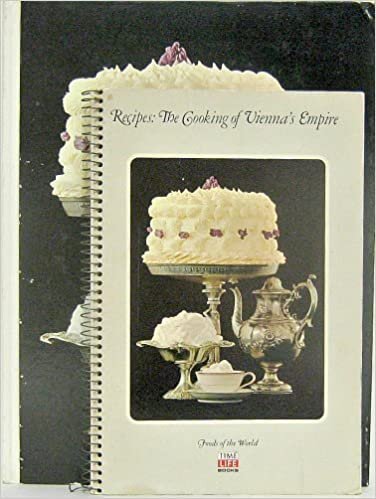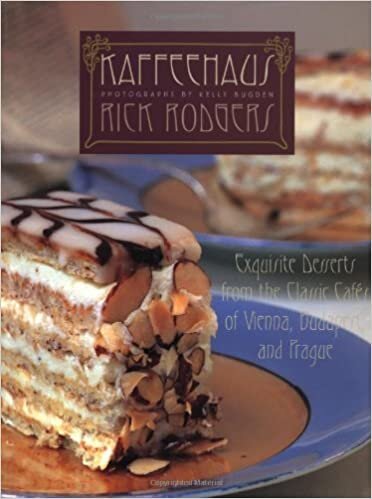Just about a month away now from the launch of I Am a Brave Bridge, my memoir with recipes of my year in Slovakia 1993–1994, I thought it was time to give a little love to an unjustly neglected cuisine at the four corners of a defunct empire.
The Cooking of Vienna’s Empire is how the Time-Life “Foods of the World” characterizes it and accordingly entitles that entry in the renowned series. I imagine the Hungarian half of the Austro-Hungarian Empire would be rather irritated by their absence from this name, but as usual, Slovaks have more cause to complain: author Joseph Wechsberg fails to include a single recipe attributed to Slovakia (even “Liptauer Cheese,” the German name for a spread from the Liptov region of Slovakia), presumably assuming—as Czechs are wont to do—that Slovak is a subset of Czech.
For all that, it’s a marvelous cookbook and a good place to start if, as is generally the case in the English-speaking world, central Europe is kind of a blank on your mental map. Wechsberg will teach you to love kohlrabi in chicken soup and why cold cherry soup is not dessert. You will discover more dumplings than you ever even knew existed (which nevertheless only scratches the surface of the Austro-Hungarian-Czecho-Slovak dumpling pantheon) and not one but two ways to serve carp. Naturally you’ll find a recipe for chicken paprikash and several kinds of goulash (no macaroni here, thank you very much), many ways to serve sauerkraut, many more ways to serve pork, and a startlingly good entry for venison with red currant-cream sauce. But the star of the book is clearly the desserts—as it should be. Pancakes, cookies, tortes, cakes, strudels, doughnuts…! Vienna’s sweet cuisine is probably the best justification for empire that ever existed.
Wechsberg wrote quite a lot of other books, actually, including a memoir entitled Blue Trout and Black Truffles, which delightfully recounts his Czech and Viennese culinary upbringing before segueing into a boilerplate ode to how Paris transformed his tastebuds. I mean, I like eating in France, too, but at this point the theme has been done to death, and no small part of me is irritated at the corresponding neglect of other great cuisines, European and otherwise, and not least of all Austro-Hungarian.
The point is made well enough by the title of David Bouley’s glossy photo cookbook East of Paris. You might be forgiven for thinking that it means the cooking of, say, Champagne or Lorraine or Alsace, all east of Paris, but no, it’s actually about Vienna. The ridiculously unhelpful title no doubt accounts for the failure of the cookbook to grip the imagination or make the point about what great dishes the world was missing out on.
A much better glossy photo cookbook to commend the overlooked is Rick Rodgers’ Kaffeehaus, and with an alluring title, no less. Unlike Wechsberg’s honest effort get the Anglo-Americans interested in boiled beef and schnitzel, Rodgers goes for the throat—or gut—with nothing but the “Exquisite Desserts from the Classic Cafés of Vienna, Budapest, and Prague,” according to the subtitle—and yes, Bratislava fails to make the cut. Quelle surprise.
However, Rodgers outdoes Wechsberg in actually including a distinctively Slovak recipe, though under its Hungarian name, Pozsony Kipfli. This is less offensive than it seems, since Pozsony was the Hungarian name that Bratislava bore for most of its history, the Viennese calling Pressburg, and the Slovaks inventing the name Bratislava in the early twentieth century in tandem with their nationalist movement. Anyway, I never actually came across this crescent of yeast dough filled with sweet walnuts in my family’s six-year sojourn in Slovakia but only tasted it for the first time at a formal event in Bratislava in 2017, at which I ate approximately a dozen and a half of them. I may be undercounting. A worthy recipe to be the sole Slovak representative. (My rather sloppy rendition is pictured here on the left.)
Kaffeehaus also has some great poppy seed-based cakes, not one but two kinds of Sachertorte, many good uses for red currants and hazelnuts, and—my personal favorite—Flódni, a Hungarian Jewish cake stacked with alternating layers of crust, apples, walnuts, and poppy seeds, kind of the grand slam of central European confectionary.
Then there is the quasi-encyclopedia Gourmet’s Old Vienna Cookbook: A Viennese Memoir by Lillian Langseth-Christensen. Graced with both lavish photos and illustrations by hand, this book attempts to record pretty much every Viennese recipe you could hope to find. Its encyclopedic nature imposes a typographic limitation: the ingredients are not listed out at the beginning of the recipe and there are no numbered steps, but rather, Elizabeth David-fashion, each recipe is a dense, terse paragraph of instruction addressed to an already competent cook. It’s definitely a book to look up something you had in a restaurant during your weekend in Vienna rather than to set out a weekly meal plan—not least of all because the sort of ingredients you could take for granted as both available and cheap in old-world Vienna are neither in your average American town. But it does convey the grandeur, complexity, and logic of Viennese cooking to rival anything that Escoffier and Carême encoded.
Speaking of encoded complexity: a further worthy rival is the life’s work of esteemed Budapest restaurateur Károly Gundel of the Crown Prince István Hotel as documented in Gundel’s Hungarian Cookbook. An English translation of the Gundel compendium, complete with lavish border, lavish photos, and annoyingly center-aligned text, can be found in the oddest places—my mom got hers in Slovakia, but I picked mine up at a secondhand sale in Strasbourg, and just recently spotted another copy on the shelf of a café here in Tokyo run by a German woman and named, fittingly enough, Kaffeehaus. Each recipe is numbered, variations identified by letter, and cross-references abound, not to mention scientifically precise charts.
Pörkölt in all its many varieties
Although it draws on traditional of Hungarian home cooking, this is definitely a restaurant cookbook. While I’ve made a few favorites—gulyás (i.e. goulash), pörkölt (another paprika-based braise), lecsó (tomato and green pepper stew), sauerkraut, and the lavish Gundel-style crêpes with chocolate, rum, raisins, orange peel and walnuts—most of them are out of my league. Alas, but crayfish strudel, consommé with Tokay, goose liver in goose fat, veal medallions, stuffed pheasant à la Széchenyi, and “Gellért’s parfait bomb” will not be gracing the Wilson table any time soon.
Always last, but unjustly least, comes Slovak cuisine. You can find any number of odd homegrown cookbooks put together by immigrant communities in the U.S., usually church ladies of some kind or another, nearly always without context or explanation. (For instance, why cabbage rolls should always be boiled beyond recognition. Did they think undercooked cabbage was going to kill you?) But any true devotee has to get her hands on the Vel’ká farebná obrazová kuchárka, the “Big color picture cookbook.” My edition is from 1990, but given the fact that the Velvet Revolution took place in November 1989, it’s representative rather of Slovak cuisine under the limited access of communism, itself drawing on the conventions of traditional countryside cuisine. Which means you get an extraordinary kaleidoscopic recombinations of a limited number of ingredients. (Actually, this is a feature of any traditional peasant cooking. We once spent a month in rural Spain and discovered that rural Spaniards eat only Spanish food: amazing ham, terrible bread, tuna, chickpeas, and red peppers. It’s embarrassing how quickly the thrill was gone.)
This book, too, verges on the encyclopedia. Its soup section alone could occupy you for a year and inspire shame at the narrowness of your vision hitherto. What you have never thought to do with ham and potatoes is a nation of its own. There are uniquely, distinctively Slovak adaptations of Hungarian, German, Austrian, Balkan, Italian, Mexican, Indian, and Chinese flavors, and then truly bizarre concoctions out of left field, like a tower of pork and orange slices. You can make your own headcheese, or veal cutlets stuffed with hot dogs (really). They love things stuffed inside of other things. The cover photo for the section on “Meatless Meals” prominently features bacon. I’m sure I’ve tried half the desserts, from spongy layered slices to crumbly nut cookies, homemade by Slovak cooks. I can’t even tell you how hungry this book makes me.
Well, the world is still going to have to wait a while before I manage to extract an English-language cookbook of Slovak cuisine out of Ellen I. Hinlicky, who has been documenting Slovak home cooking almost as long as she has been my mother. In the meanwhile, you’ll have to settle for the fourteen recipes at the end of my memoir—one for each chapter—to give you a little taste of what you’ve been missing: Anna’s Carrot Soup, Filled Pancakes, Fried Cheese, Poppy Seed and Walnut Rolls, Garlicky Cheese Spread, Stuffed Potato Pancake with Liver, Open-Faced Sandwiches, Sour Codfish Salad, Scrambled Eggs with Oyster Mushrooms, Marka’s Communist-Industrial Sheep Cheese Dumplings, Montenegrin Cutlet (my favorite of the bunch), Noodles with Poppy Seeds, Sweet-and-Sour Lentil Soup, and Mashed Potato Pizza. Mňam!
Or, to summarize the point of this post: forget Paris!
Click on the cover below to order your copy of my memoir from Amazon!











